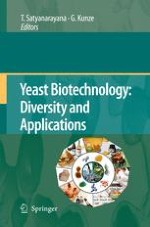
2009 | OriginalPaper | Chapter
Antarctic Yeasts: Biodiversity and Potential Applications
Authors : S. Shivaji, G. S. Prasad
Published in: Yeast Biotechnology: Diversity and Applications
Publisher: Springer Netherlands
Activate our intelligent search to find suitable subject content or patents.
Select sections of text to find matching patents with Artificial Intelligence. powered by
Select sections of text to find additional relevant content using AI-assisted search. powered by
This review is an attempt in cataloguing the diversity of yeasts in Antarctica, highlight their biotechnological potential and understand the basis of adaptation to low temperature. As of now several psychrophilic and psychrotolerant yeasts from Antarctic soils and marine waters have been characterized with respect to their growth characteristics, ecological distribution and taxonomic significance. Interestingly most of these species belonged to basidiomycetous yeasts which as a group are known for their ability to circumvent and survive under stress conditions. Simultaneously their possible role as work horses in the biotechnological industry was recognized due to their ability to produce novel enzymes and biomolecules such as agents for the breakdown of xenobiotics, and novel pharmaceutical chemi cals. The high activity of psychrophilic enzymes at low and moderate temperatures offers potential economic benefits. As of now lipases from
Pseudozyma antarctica
have been extensively studied to understand their unique thermal stability at 90°C and also because of its use in the pharmaceutical, agriculture, food, cosmetics and chemical industry. A few of the other enzymes which have been studied include extracellular alpha-amylase and glucoamylase from the yeast
Pseudozyma antarctica
(
Candida antarctica
), an extra-cellular protease from
Cryptococcus humicola
, an aspartyl proteinase from
Cryptococcus humicola
, a novel extracellular subtilase from
Leucosporidium antarcticum
, and a xylanase from
Cryptococcus adeliensis
The ability of these yeasts to adapt to the low temperature conditions has also led to investigations directed towards characterizations of cold stress proteins and heat shock proteins so as to understand the role of these stress protein with respect to adaptation. Antarctic yeasts have also been used as model system to study the inter-relationship among free radicals, antioxidants and UV-induced cell damage